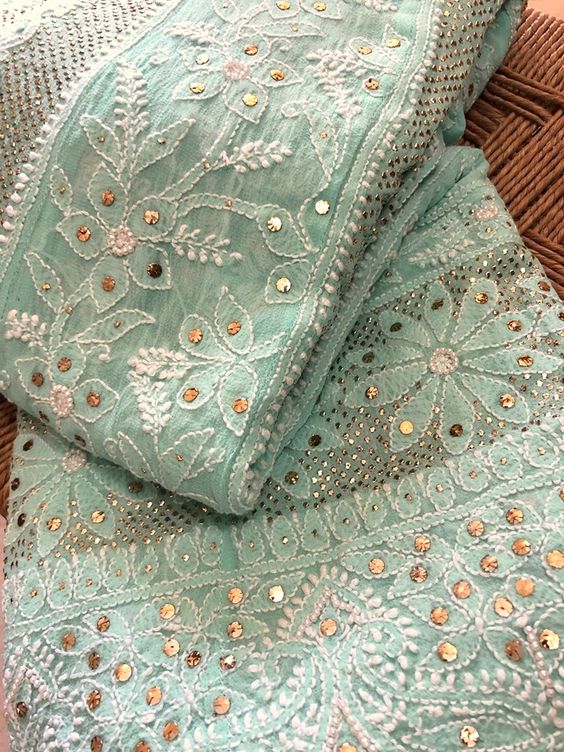
Lucknow, a city which is embedded in elegance, exquisiteness, and affection, has kept a rich heritage of handicrafts in its heart for centuries. A perennial love story of needle and thread, which is narrated through hours and days of toiling by artisans known as Chikankari.
Chikankari is a fine art of embroidery made with white untwisted yarn with the help of a needle on a fine cloth. Most craft enthusiasts have a metaphor of painting with a needle over fabric. The Lucknow chikan was the purest indigenous needlework of India, according to George Ward, the director of the Indian Art Exhibition in 1903. Kamala Deva Chattopadhyay, a social reformer and a driving force behind the Renaissance of Indian Handicraft, described it as subtle white and white stitches.
Etymologically, the word “chikankari” is derived from the Persian word “chik”, which means to make delicate patterns on fabrics. The origin of this style of embroidery can be traced to Megasthenes, who was a Greek traveler who came to India in the 3rd century and mentioned in his classic work that the ruler used to wear white muslin embroidered with white thread. It is also said that more than 400 years ago, Mughal Empress Nur Jahan brought a delicate hand embroidery from Central Asia to India, and it took firm roots in Lucknow and its surrounding areas. It is opined that Nur Jahan learnt this exotic embroidery and innovated the idea of tracing the floral designs of monuments and minarets over delicate muslin cloths, which made the pattern more sophisticated and gave new direction to this work.

In the eighteenth century, when the Mughal Empire was declining, the patronage of this came into the hands of nawada and regional rulers. The Nawabs of Awadh and the surrounding area were major patrons of Chikankari work, as they wore Chikankari topis(caps), kurtas, kaftans, and other garments.
Initially, chikankari was done on muslin or plain cloth made from white thread, but over time, more light colors and fluorescents were incorporated into it. Chikankari requires soft fabrics like silk, chiffon, georgette, net, fine cloth, kota, doria, organza, cotton, and synthetic fabrics as these are hand stitched. Due to the soft fabric, not only does the veneer remain light and embroidery is done easily on it, but the workmanship on it looks different. These kinds of skills are used in ornating garments like kurtas, plazos, sarees, and many others. Nowadays, even household and home decor items like embroidered lampshades, sofas, and table covers are available.
The making of Chikankari embroidery over fabrics is a laborious and toiling task. The process can easily be divided into two parts— the pre- and post-embroidery— stages and according to artisans, there are 36 forms of stitching that can be used in the process of embroidery. The stages of Chikankari works are as follows:
- Block Painting– This is the initial stage in which the design is made on the fabric. The fabric is cut according to the form of the dress. The design is then printed on the cloth with blue ink wooden prints.
- Embroidery– Embroidery work is usually done by women. The fabric is placed in a small frame and then the needle is inserted into the fabric with the right hand. The left hand controls the thread so that the stitch is in the pattern being printed. The type of stitch a craftsman chooses depends on the specialty of the area and the type and size of the motif.
- Washing– After the embroidery work is completed, the fabric is soaked in water to remove the outline of the pattern. After this, kalaf is applied to make the cloth tighter. Kalaf is applied according to the type of cloth.
- Jali– Jali stitching is the specialty of Lucknow. In this technique, fine stitching is done on the hinge of the button with a large blunt needle to make a lattice. In this technique, the thread never crosses the fabric, and it is impossible to distinguish between the back and the front.
- Tepechi– In this stitch, the weave is done on the right side of the fabric and this creates the outline of the motif.
- Murri– This stitch is used to make rice grain-shaped designs in intricate patterns.
- Bakhiya– It is also called shadow stitch. In this, the back side of the cloth is stitched with thread, whose outline is visible towards the front of the cloth, and the light color of the thread is also visible.
- Chain– Chain stitch is used to make the outline of the flower-leaf, especially when these flowers and leaves are attached to the pattern.
- Hool– This is called eyelet stitching. From this, the design of the middle of the flower is made.
- Noda– This stitch in the shape of a millet is used to make vines of flowers and grapes.
- Rahat- In this technique of one stitch, the stalks of trees are made, but in the Bakhiya technique, double stitch is also used.
- Nail Bracelet– This technique of sewing is used to make flower motifs and petals.
- Khatua– This stitch is considered to be an improved form of Bakhiya, which is used for making flowers and bell boots. The motif is first woven on the plain cloth, and then it is lowered onto the main cloth.

Stitching is the main feature of Lucknow Chikankari. Every stitch is done with meticulousness and a precision that is hard to find anywhere else. The fine and artistic embroidery done by hand gives a distinct look to the veneer.
The varieties of Lucknow chikan have become more than what they used to be. They are in high demand among the common people of the city, the upper class and the celebrities of Bollywood and Hollywood. The Geographical Indication Registry named Lucknow Chikan in December 2008 as G.I. was given the status. Today, 2.5 lakh artisans work in the Chikankari industry, which is one of the largest gatherings of artisans in India.

During industrialization in the eighties, when Lucknow chikankari came into play again, it also started getting commercial and cheap imitations. To reduce its cost, new varieties of clothes and embroidery machines came. After this, when the new profit-making era of Indian fashion came, small and big designer companies started adding crystal, mukesh (badla), and zardozi to the chikan to make the product more beautiful. In the last few years, there has been a tremendous change in the form of chikankari in terms of creativity and experimentation with different types of fabrics and embroidery. However, not only did it enhance the culture of Lucknow, but it has also become a livelihood for millions of women who spend their hours making these beautiful designs. Laila Tyabji, the founder of Dastkar, compared Chikankari works with a dragon fly’s wings, since just like the shine of its wings, it has luminated the lives of these women, making them self-dependent.

Swaliha Malik
Swaliha Malik is a History undergraduate at Miranda House who is curious to Religion and Modern History. Apart from being a history buff, she is a feminist who sees the world and societal norms through critical lenses. In her free time she binge watches, read, research and drinks coffee.


What¦s Going down i am new to this, I stumbled upon this I’ve found It positively helpful and it has helped me out loads. I’m hoping to give a contribution & help other users like its helped me. Good job.
There are some interesting closing dates in this article however I don’t know if I see all of them middle to heart. There may be some validity however I will take maintain opinion till I look into it further. Good article , thanks and we want more! Added to FeedBurner as effectively
What i don’t realize is actually how you’re not actually a lot more smartly-liked than you may be right now. You are very intelligent. You know therefore considerably with regards to this topic, made me individually imagine it from numerous various angles. Its like men and women are not involved until it is one thing to do with Lady gaga! Your individual stuffs nice. Always care for it up!
Perfect piece of work you have done, this web site is really cool with great information.
Hello my loved one! I wish to say that this post is amazing, nice written and include almost all vital infos. I would like to peer more posts like this .